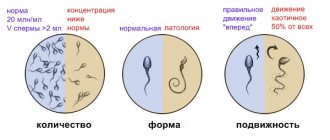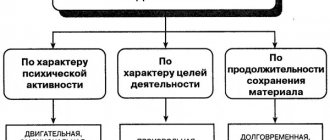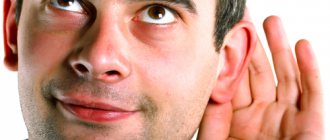Development of memory in preschool children. It is impossible to imagine a mentally healthy person without memory. This simply cannot happen. After all, memory is a tool with which an individual can apply his experience and rely on previously acquired knowledge. It is important to teach your memory to work correctly so that it does not fail. For this, a fertile period will be preschool age, when the emergence and development of mental activity occurs.
Features of memory development in a preschool child
Each time period of a person’s life is different from others, because at each stage new knowledge comes. In addition, the ability to remember depends on a person’s physical and mental abilities. In preschool age, memory is excellent, the child literally grasps everything on the go. Everything he learns interests him; this is the process of cognition. But what seemed uninteresting will remain overboard.
Memory is a meaningful action. If a child does not understand something, he will not remember it. Involuntarily, things that touched and impressed the child are remembered. And in order to remember something that, in a child’s opinion, is not at all interesting, you need to work hard. Meanwhile, the child who is already learning to analyze, compare, generalize, and masters other operations of mental activity remembers better.
Bright pictures are very important for children; their eyes catch colorful illustrations, and their brain forces them to put these images in their memory. Movement also helps memory. A child cannot be passive, so outdoor games and exercises help develop his memory.
The first important stage in the period of growing up of a preschooler appears at the age of four. If before this period there were first actions that gave rise to memorization, then in the middle group of kindergarten the child can already remember the words spoken to him and perform some actions based on instructions. He can even plan some actions himself based on the remembered material, and first of all, the support for these memories will be the child’s personal observations.
At the age of five, a preschooler comprehends logical memorization; adults help him with this when they give some instructions or explanations for any actions. During this period, the interaction of mental operations is important.
HOW TO TEACH A CHILD TO MEMORY
A preschool child must be specially taught the art of memorization. If you devote enough time to your child during the preschool period, there will be fewer problems in primary school with mastering new knowledge. The child will now control his own thought process and will be taught techniques for quickly memorizing the proposed information.
Didactic games contribute to the necessary development of voluntary memory in preschoolers
Mastery of basic memorization techniques in preschool age depends on the following conditions:
· Content and nature of the material intended for the child. A preschooler remembers more easily what interests him and evokes any memorable emotions and feelings.
· The nature of the learning process. It is necessary to properly organize activities with the child, you need to ensure that memorization becomes a logical chain.
· The child must know why accurate memorization and subsequent recall are necessary.
· To encourage a child to engage in mental activity and develop long-term memory, it is necessary to check the results of mastering the material.
The necessary development of voluntary memory in preschoolers is facilitated by didactic games, during which children must follow certain rules and observe certain features of the order of actions.
Types of memory
Development of memory in preschool children. There are several types of memory.
- motor,
- emotional,
- verbal-logical,
- figurative.
In turn, it is necessary to note involuntary memory, when images and objects are remembered as if by themselves, without any effort, and voluntary, when a diligent process of memorization is underway. Involuntary memory is typical for younger preschoolers. Older preschoolers are already beginning to master voluntary memorization.
Emotional development of a preschooler
What types of memory predominate in preschool age?
Activation of a preschooler's memory occurs through perception. Information reaches the child through visual, auditory, taste, and tactile receptors. The received signals form a certain image that the child remembers. For this reason, due to nature, the predominant type of memory in preschoolers is figurative.
The following types of memory develop intensively in preschool children:
- figurative
- verbal
- motor
Figurative memory helps the child master new concepts and expand his vocabulary.
Having heard that a zebra is a striped horse, the baby quickly forms the image of the animal. The new information for him is the word zebra itself.
Perhaps the child’s imagination drew a not quite similar image. In reality, it will correct itself. In the meantime, the new word will already be firmly established in the preschooler’s vocabulary. The formation of verbal-logical memory occurs.
Thus, the development of memory in ontogenesis goes from the predominance of figurative to the use of verbal forms. We can say that speech takes a preschooler’s memory to a higher level and increases its productivity.
Motor memory in preschool age is oriented towards a given pattern. These are no longer the simplest movements (assembling a pyramid, threading a button through a loop) that are mastered at an early age. A preschooler, looking at an adult, learns dance movements. Masters such complex household operations as tying shoelaces and sewing on buttons.
Memory of children of primary preschool age
In early preschool age, images are formed on the basis of practical actions. A 3-4 year old child learns about the world through actions and remembers the most important things for himself.
Information is stored fragmentary, in the form of figurative single representations. So, a child may be afraid of Santa Claus, and no explanation that dad dressed up in this costume for the next holiday will help.
At this age, the most emotional events, bright objects, and frequently repeated actions are remembered.
The separation of features and their generalization during comprehension and memorization is formed due to the development of speech. When a preschooler masters more concepts and uses words, his perception becomes more stable. This, in turn, helps the child associate the content with a specific word and remember it as an image. But in younger preschoolers, such linking occurs involuntarily.
Features of memory in older preschool age
The older a preschooler gets, the stronger the connection between memory and thinking becomes. The child masters his native language, learns to analyze, compare and generalize. As a result, images are remembered through mental operations.
The older preschooler himself makes up descriptive definitions in order to remember the new concept. An escalator is also a staircase, only it moves. Blackberry is called that because it is covered in thorns, like a hedgehog.
But in older preschool age, in order to remember and remember, support in the form of an image is not always needed. Poems are remembered for their rhythm and rhymes, as the sound culture of speech develops. When retelling a fairy tale or story he has heard, the preschooler relies on a logical sequence of events. Although he can equally imagine himself in the role of one of the characters, which promotes memorization.
The peculiarities of memorization and reproduction in older preschool age also manifest themselves in the fact that they gradually acquire an arbitrary character.
Reproduction forms
Forms of reproduction can also be divided into groups.
- The simplest thing is recognition. If a person has seen or heard something before, he will certainly recognize it.
- The second form is memory. For memory it is not important to see the object. It is important to remember its signs.
- The third form is recollection. In this case, remembering can be difficult; in order to remember, you need to make an effort and character.
- The fourth form is forgetting. It is impossible to remember everything all the time. Forgetting is the case when the brain refuses to remember the characteristics of an object or replaces one object or phenomenon with others because recognition is blurred.
In preschoolers, figurative memory dominates. He remembers the signs of an object and phenomenon, if they are vivid and catch his imagination. Can remember minor details, but most importantly, forget important things.
In addition, when working with children, you need to remember another feature of the children's brain: selectivity. Everything that is interesting to a preschooler is remembered without difficulty. Everything that is boring and uninteresting is immediately forgotten, because there is no fixation on its main features.
The third feature: repetition is the mother of learning, teachers say following the author of the historical phrase. If a child repeats the same actions over and over again, he automatically remembers.
The fourth distinctive feature of a preschooler’s memory is that emotional influence leads to memorization. What touches you cannot help but leave a trace in your memory.
When the amount of information accumulates, with the development of perception, the child is able to master coherent and systemic ideas. And the next step will be meaningful operation of the acquired knowledge.
Formation of memory as a basic mental function
The cognitive development of a child is unthinkable without the active use of memory. This mental process allows you to accumulate, store and recall the necessary information. The memory of a preschooler expands its capabilities every year.
In the first years of life, memory is formed as a component function of perception. The most striking characteristics of those objects that are perceived by a child are involuntarily recorded by brain cells. Information is accumulated about surrounding people, about various objects, about their properties, about repeated actions. At the age of three years, memory already acts as an independent cognitive function.
The simplest form of recollection is manifested in the baby's recognition of objects that he has already seen, heard or touched before. In preschool age, the functional capabilities of receiving and retrieving information are actively developing, which ensures more complex memory work. A preschooler uses all memory functions:
- memorization
- preservation
- recollection
- recognition
- playback
Memorization is carried out by “linking” new material to already familiar material. For a preschooler, such consolidation occurs fleetingly. Children do not yet know how to use special memorization techniques.
Retention is a mental process that ensures that information is retained for a certain time. It can be both short-term and long-term. Young children can remember for a long time what caused special emotions. Fear may linger for a long time, but the baby can also retain impressions of joyful events.
Recall is the process of retrieving previously remembered information. The request on the way home: “Mom, buy me a doll like Olya’s” is nothing more than a recollection of one’s own admiration for Olya’s treasure.
Recognition is an easier way to remember familiar information because it relies on a newly seen, heard, or felt stimulus.
Reproduction is a complex process of retrieving already stored material. The limited life experience of a preschooler also imposes restrictions on the reproduction of information. The child remembers under the influence of similar impressions.
The main feature of a preschooler's memory is the predominance of involuntary memorization. Playback works the same way.
Norms of memory development in preschoolers
For a specific age stage there are different norms.
- Up to a year - motor memory, there are reflexes, memorization at the level of emotions.
- 1-2 years – development of the nervous system, figurative memorization.
- 2-4 years – development of mechanical memory, memorization and logical thinking skills, recognition predominates, interest is important for memorization.
- 4-5 years – involuntary memorization, voluntary begins, recall prevails.
- 5-7 years - arbitrary. The volume of normal memorization is from 8 out of 10 items.
Developmental techniques for children
How to measure a child's memory
Development of memory in preschool children. You can measure your child's memory using special tests.
Visual memory
The child is invited to look at the pictures. It will take one and a half minutes to open. Then the child is asked to draw from memory what he saw.
If the child correctly drew most of the objects, his memory is good. If not, there are memory problems.
Another option is to show the child pictures, ten in total. Then they ask him to name the objects he saw.
If the child correctly named more than 8 pictures, his memory is good. If you made a mistake about five times, the result is average. If you made more than five mistakes, then your memory is bad.
Auditory memory
The teacher calls out the numbers, the child must repeat after him. If the child names at least 5 numbers from a series correctly, then his memory is good.
Recognition test
The child is shown a picture depicting certain objects. Then he is asked to find these objects in a large picture.
If a child managed to find at least eight out of 10 objects, his memory is good. Made more than five mistakes - the result was weak.
Development of memory in schoolchildren
When a child enters first grade, he immediately finds himself in an unfamiliar environment. From the first days of school, he has to memorize large amounts of information. As the student gets older, the workload will increase. If he does not have good memory and attention, then studying will be more and more difficult for him every year. That is why it is necessary to pay special attention to the development of memory in a child over 7 years old.
It is important to teach him to remain focused on lessons and to voluntarily remember the information that he receives from the teacher’s lectures and textbook texts. To do this, you need to regularly perform various exercises that are aimed at improving the skills of perception and assimilation of new knowledge. No less useful for memory development will be reading and discussing books, memorizing poems, writing summaries - that is, those tasks that the school curriculum already includes.
Sometimes such simple training is enough to improve memory and attention. But if it is still not easy for a child to cope with the academic load and remember large amounts of material, then he needs additional training.
Exercises and games to develop memory
Remembering that it is easier for a preschooler to remember things that he understands, you need to build the learning process through play, based on motor activity and emotions caused by interest.
Development of figurative memory
Development of memory in preschool children. The child’s ability to involuntarily memorize objects can be used in the “Classification” game. In this case, the child is offered several pictures with images of some objects. The child needs to arrange the illustrations into groups. For example, he must arrange pieces of furniture into “rooms”: bedroom, living room, kitchen, bathroom. Or there are pictures of animals. The child should put domestic animals in the “house” and wild animals in the “forest”.
The game “Shop” will help to develop figurative memory. The child shopper “does” the shopping, who must put into a basket the items he was told to “buy.”
Development of imagination in preschool children
Development of auditory memory
When a child hears some information, he mentally processes it and only then takes action. What if the child does not know how to listen and hear? Then there is no need to talk about his future success at school. Therefore, it is very important for preschoolers to develop auditory memory. You can use these exercises.
Verbal relay race
In this game, the leader names a word. The child must repeat the word that the leader said and say his own word. Then it’s the presenter’s turn. He names these two words and adds a third. Child's turn: he repeats all the words and adds a fourth word. It is desirable that the words be on a specific topic: “Summer”, “Vegetables”, “Transport”, “Dishes”, etc. The one who made a mistake, knocked down the verbal chain, lost.
Game of colors
In this exercise, the child must color the picture. But before that, he listens to a text passage that talks about the plot in the picture and names the colors. For example, in the picture there is a house with a brown roof, red apples grow on the tree house, and blue flowers grow in the clearing. In order to color the picture correctly, the child must remember the text.
Tact
Clap your hands or knock with a hammer, beating time. The child must repeat the sound combination.
Methods for developing and training memory
To see a positive result from training any intellectual abilities, you need to do the exercises regularly and systematically. If training is subject to a specific program, then the improvement of skills occurs consistently and more effectively, and the development of memory and attention in children is no exception.
But at home it is not always possible to make learning productive, because parents have to not only select exercises for the child, but also control how often he practices. This approach takes a lot of time and effort, but does not guarantee that the classes will bring noticeable results. Therefore, it is better to improve the abilities of schoolchildren in children's centers, where training is conducted under the supervision of experienced teachers according to a time-tested program.
One of these courses is Memorica - a method for developing memory and attention from the AMAKids Academy for the Development of Intelligence. It is an effective program for training intellectual abilities, which is suitable for children from 7 to 16 years old. During the training, children master different techniques for memorizing information and learn to apply them in practice. All this will help not only while studying at school, but also in adult life, because the skills acquired in the classroom will be preserved forever.
Development of visual memory
Development of memory in preschool children. Bright pictures attract children's attention, but are kids able to retain the image in memory? To develop their abilities, you can invite preschoolers to play the following games:
"Restore the pattern"
A pattern is laid out on the surface using painted parts. The child remembers it. Then the child is asked to lay out the same pattern from memory.
"Scout"
There are objects on the table. The child looks at them and remembers what and where it is. Then the child turns away, and some objects are swapped. The child must name the objects that were moved.
"Walk"
While walking, the child sees many colors and objects, he involuntarily remembers what attracted his attention. An adult should help focus attention. After the walk, you can ask your child to draw what he remembers.
Peculiarities of children's memory
The development of memory depends on the child’s living conditions, his upbringing and education.
Under the influence of external influences, temporary connections begin to form in the child’s brain, which form the physiological basis of memory. Already in the middle of the first month of life, the formation of the simplest conditioned reflexes can be observed in the baby. Thus, a two-month-old baby, accustomed to being picked up before feeding, begins to calm down and seek the mother’s breast with his lips as soon as he is taken out of the cradle. Somewhat later, towards the end of the first half of life, the child begins to recognize.
For example, the appearance of a mother who takes care of the child on a daily basis causes a positive reaction in him: he smiles, claps his hands, and makes quiet sounds. Such recognition requires the establishment of more complex temporal connections between the child’s responses and a certain set of stimuli. Gradually, the baby's range of recognizable objects expands. Following recognition comes memory. A child, for example, tries to look for a missing thing by turning his head to the side.
This suggests that he has a memory of an object that is not currently perceived. Initially, the period of time during which an impression is retained in memory is very short. A one-year-old child perceives only what happened a few days ago. By the age of 3, the duration of memory retention increases to several months. The strength and duration of memorization in a 4- or 5-year-old child becomes so significant that a number of impressions received at this age are retained for life.
Preschool age is characterized by intensive development of the ability to remember and reproduce. The memory of preschoolers is mainly involuntary. Children do not yet know how to set themselves the task of remembering and do not accept such a task from adults. The material that is included in the active activity is involuntarily imprinted. Memorization and recollection occur independently of the child’s will and consciousness and depend on the nature of his activity. That is why new knowledge should have some meaning for the baby: the more this information comes into contact with his interests, the easier he it .
The memories of a preschooler have a clearly visible, figurative character.
Visual material (objects and their images) in preschool age is remembered much better than abstract statements. From verbal material, figurative descriptions are retained in memory much better, especially when they are artistic, emotionally expressive in nature. When, for example, a child is given some material (toys, blocks, pictures), without giving him a special task to remember it, then, playing with it, making buildings from it, etc., he remembers it very well.
But if, having given him the same material, you insistently demand that he remember it, the child sits confusedly over it, doing nothing, and in the end does not remember anything. Memory as a special purposeful activity - as voluntary memorization and recollection - has not yet developed in children of this age.
In the middle of preschool age, under the influence of education, voluntary memorization and recollection gradually begin to take shape. By participating in collective games and organized activities, the child gradually learns to remember what those around him require of him, as indicated by the teacher. In memory processes, the role of the word, the second signaling system, increases.
Voluntary memorization and recall initially arise under especially favorable conditions. For a preschool child, it is very important that the task of remembering something is supported by the achievement of a direct result in his practical activity. If you simply tell a preschool child: “Remember this!”, then such an instruction in most cases does not achieve the goal, since it is not related to his activity. But if the task of remembering is associated with the completion of some important task given by an adult, or is part of the content of an entertaining game, then the child accepts the task, and he begins to actively strive to it .
At first, a preschooler’s voluntary memorization is very imperfect. The child does not know memorization techniques; he does not yet know what needs to be done in order to remember better. Gradually, with the correct organization of educational work, by the end of preschool age the child learns to consciously use the simplest memory techniques. In order to remember some material, the child carefully becomes familiar with it, repeats it several times, strives to establish appropriate connections, etc.
In the development of voluntary memory in a preschooler, the organization of educational work plays a decisive role. The child does not invent the task of memorization, methods of memorization and recollection himself, they are organized by an adult. The adult invites the child to remember this or that, organizes activities in which this task can be solved, indicates some techniques that promote better memorization, etc. When the child gains some experience in this regard, he himself begins to set himself the task of memorizing , on his own initiative, voluntarily remembers or recalls the necessary material. The development of voluntary memory is important for preparing a child for school.
The amount of memory will depend on the state of visual and auditory perception and attention. Therefore, it is necessary to develop these abilities and speech in children from an early age in order to promote the development of all types of memory. The development of memory is also influenced by the level of mental abilities: the more a baby can do, the more actively he thinks about something, the more he is able to remember. As the child grows up, his mental abilities develop, and memory develops along with them (Zaporozhets A.V., 1953)
Development of motor memory
To develop motor memory, you can play “puppet”. The child stands calmly, and the adult controls his arms and legs, forcing him to go right, left, forward. Then the child is asked to repeat the movements from memory.
You can also use the game “Do as I do.” The teacher makes the movements, the child repeats after him.
Developmental activities for preschool children
Development of arbitrary logical memory
The ability to classify leads to the development of arbitrary logical memory, so it is important to give children exercises where they must use methods of classification, analysis, comparison and generalization.
Didactic game "Cards"
Children are asked to select images based on specific characteristics and arrange them in piles. For example, from pictures with birds and animals, you need to put pictures with birds in one group, and pictures with animals in another. Themes for the game can be different: sports, furniture, seasons, plants, etc.
"Twins"
Among different pictures, the child must find two identical ones.
Memory impairments in preschoolers
Considering that the development of memory processes in preschool children is closely related to all cognitive processes, disruption of its development can negatively affect the intellectual development of the child as a whole. It will also significantly complicate his future training. For example, poorly developed short-term memory deprives a child of the ability to properly remember lesson material and respond to teacher requests. A low level of visual memory development inhibits the development of writing and reading skills. All this inevitably leads to the child’s academic performance falling, and others perceive this as a manifestation of laziness, lack of educational and cognitive interest, etc. Children who are unable to master the school curriculum are more likely than others to violate discipline and experience difficulties in relationships with teachers and peers.
Children with memory impairment are more likely to show deviant behavior
Development of long-term memory
Development of memory in preschool children. To develop long-term memory, you need to teach a child not only to recognize, but also to reproduce information. Long-term memory is impossible without expanding the horizons of a preschooler. In this case, exercises with texts and illustrations help.
Preschoolers are offered several pictures depicting animals and various objects. And there is a suggestion: remember all the animals, for example. Or remember all the dishes that are in the pictures and then name them.
A good option would be to compare pictures that differ in minor details.
Methods for developing tactile memory
Tactile memory is a person’s ability to remember the sensations of touching a particular object. To develop tactile memory you will need the following exercises:
"Find by touch"
The child is asked to choose one from a variety of objects based on specific tactile characteristics. For example, a child is told that this object is soft and fluffy. Or rough, prickly.
"Game with mood"
The child has associations about objects. If an object is soft and pleasant to the touch, then this object is in a good mood. Which object is in a sad mood? Or evil? The child, relying on tactile sensations, selects objects.
"Tales with tactile details"
In this case, the child participates in a theatrical production, where the plot of a fairy tale is heard, and all the characters and objects surrounding them can be touched and determined what they are: soft, rough, hard, prickly, etc.
Games to develop fine motor skills in children
What are the distinctive features of memory in preschool age?
Noting the features of the development of memory processes in preschool children, it is necessary to pay attention to the following:
First of all, a preschooler’s memorization is still involuntary.
Memory processes classification
Because of this, the child is able to capture only the bright, catchy features of objects. This often leads to remembering unimportant, secondary features, quickly forgetting more important ones. In order for memorization to occur more intensely, the perceived information must have a certain emotional connotation. And the purpose of memorization should be clear to the child and formulated by adults in the most accessible form.
How to evaluate child development indicators
In preschool age, motor memory develops most intensively.
These features largely explain why it is at this age that it is most effective to send a child to sports clubs and dances. By memorizing the movements, the child can perform them consistently, consciously and in control of what is happening to him. A higher level of development of this type of memory is also very clearly visible in play activities: trying to adhere to the established rules, the child makes sure that others follow them.
Thanks to the development of children's memory, many actions performed by the child are brought to automaticity and do not require increased control from the mind.
Speech memory can only develop if the child constantly talks.
The child assimilates patterns, which he subsequently independently transforms into more complex ones. Moreover, over time, this rule extends not only to elementary processes, but to types of activities that require the participation of fine motor skills.
The child’s mastery of speech and the enrichment of his active vocabulary begins to play a special role in the development of children’s memory. Conversations of surrounding people, as well as listening to poems and fairy tales, the child begins to gradually reproduce them. And then use the learned speech structures when communicating, first with parents and close relatives, and a little later with friends and other children of their age. Thus, he not only accumulates certain knowledge and experience, but is also able to share it with other people. And also talk about your condition, mood, etc.
Preschool age is the period when the child begins to accumulate his own, personal memories associated only with him and his personal experience.
Sensory cognition is the first stage of memory development
As a rule, a child remembers events that play a significant role in his life and are filled with vivid emotions. The child begins to remember holidays and trips that he remembers; but at the same time remember the grievances, pain, etc.
Intensive development of voluntary memory in the preschool period is also achieved through the development of voluntary attention.
By purposefully observing certain objects or phenomena, the child begins to remember their distinctive features and characteristic properties. Subsequently, these same features will form the basis of long-term memory.
Memory impairments and their causes
Experts distinguish two main types of disorders:
- quantitative,
- quality.
Quantitative disorders are a weakening of memory, loss of any fragments. With high-quality ones, false memories and fantasies come first, replacing reality.
The causes of memory impairment in children can be:
- mental retardation, often congenital,
- trauma, physical or mental,
- an atmosphere that is not comfortable for the child, where fear displaces everything from the child’s head,
- soreness of the body, including vitamin deficiency.
What affects the development of memory in a child
Development of memory in preschool children. In order for a child’s memory to develop, you need to pay attention to the following factors:
Nutrition
The diet should be varied, healthy foods and vitamins should be included in the diet. There must be meat and vegetable products, fish, herbs, and fruits.
Healthy eating: menu for every day
Healthy lifestyle
There must be a daily routine in which you need to devote time to both walks and useful activities. The child should go to bed at a specific time and get up at a specific time. Let the child participate in a sports section or attend a development club.
Development taking into account the age characteristics of the child
Parents must understand that the child must direct his energy in the right direction. However, you should not overtire your preschooler, otherwise you may end up with constant fatigue syndrome. It’s good if developmental classes take place in a kindergarten. It is impossible to overwork a child by enrolling him in several sections and clubs at once.
Exercises for memory development in children: VIDEO
Development through exercise
The best way to develop a child's memory is through exercise. They allow you to achieve a good result that will be noticeable both to the baby himself and to everyone around him. Exercises have a positive effect on memory, logic, attention and general level of intelligence.
The following exercises are most effective:
- Sketching words. The parent needs to say the words out loud, and the child’s task is to quickly sketch them on a piece of paper. At first you need to name simple things (a chair, a car, a house), but later you should increase the complexity (old age, flying, etc.) to make it harder to paint a clear picture. Additionally, you can add adjectives to words.
- Drawing from memory. The adult shows the picture for 30 seconds, after which the child must draw it from memory. Gradually the image should become more complex.
- Memorizing words. Show the child a piece of paper with a set of words, give him 30 seconds to memorize, and then give him a blank sheet, where he must write the same words from memory. You can make the task more difficult by asking them to maintain the order of the words.
- Calculations. The parent gives the child a picture where he must count the number of certain objects. You should gradually increase the complexity of the images to make it more difficult to find the necessary elements.
- Description. You need to name the object, and the child must describe it in as much detail as possible. You should choose only those things that are well known to him. To complicate the task, it is recommended to ask additional questions.
- Comparing lists with words. The parent should give the child a list of 10 words for one minute. After this, instead of the first list, you should give a second list, where there will be the same number of words, but 7 of them must be new. The task is to find those words that were already present in the first list.
- Retelling. The parent reads a short story, after which the child must retell it as correctly as possible. It is allowed to replace reading by an adult with an audiobook or independent reading by a child. In the first two cases, hearing and the corresponding type of memory will be involved.
These memory development exercises for children will help you achieve results after just a few training sessions. However, it is important to consider that excessive stress on the brain will lead to negative results. Therefore, you should give your child time to relax and have fun.
Additionally, you can use special tasks, mathematical examples and exercises related to your studies. Such extracurricular activities will help not only in the development of memory, but will also have a positive impact on school success.











